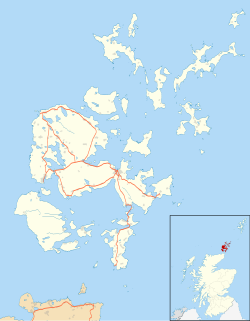| Lyness | |
|---|---|
 Approaching Lyness ferry terminal | |
Location within Orkney | |
| OS grid reference | ND305942 |
| Civil parish | |
| Council area | |
| Lieutenancy area | |
| Country | Scotland |
| Sovereign state | United Kingdom |
| Post town | STROMNESS |
| Postcode district | KW16 |
| Dialling code | 01856 |
| Police | Scotland |
| Fire | Scottish |
| Ambulance | Scottish |
| UK Parliament | |
| Scottish Parliament | |
Lyness is a village on the east coast of the island of Hoy, Orkney, Scotland. The village is within the parish of Walls and Flotta, [1] [2] and is situated at the junction of the B9047 and B9048. [3] [4]
Contents
During the 1920s Lyness was briefly the headquarters of the metal salvage firm of Cox and Danks's raising of the German High Seas Fleet, scuttled by the Germans on 21 June 1919 during the Armistice (Scuttling of the German fleet in Scapa Flow).
During the Second World War it was home to HMS Proserpine, the main base for the naval fleet based at Scapa Flow. [5]
In 2010–2011 the Golden Wharf at Lyness Harbour was upgraded to host renewable energy projects, including the Pelamis Wave Energy Converter and the Wello Penguin. [6]
Today an Orkney Ferries Ro-Ro car ferry links it to Longhope on South Walls, the island of Flotta in Scapa Flow, and Houton on Mainland, Orkney. [7]
